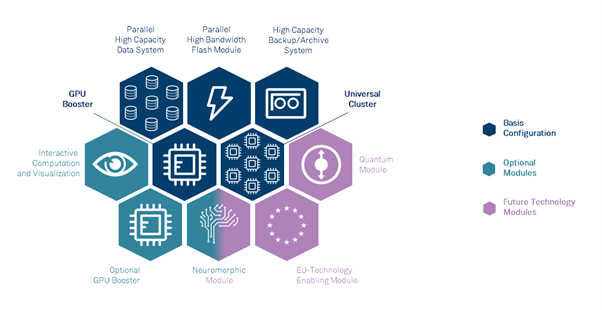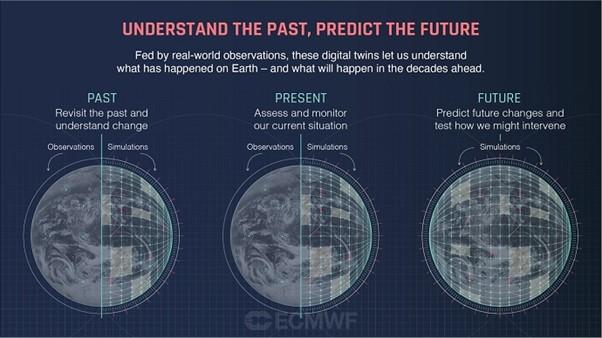Did you know that if you search “Exascale supercomputer” on the internet, you will learn that it is a computer that can perform more than 1,000,000,000,000,000,000 (1018) operations per second or more than so called 1 exaFLOPS? A typical laptop is capable of only a few teraFLOPS, that is a trillion (1,000,000,000,000 = 1012) operations per second. 1 FLOPS, or floating point operation per second, is one operation, such as an addition, done by a person with pen and paper in one second (assuming this was possible).
To put this into perspective: if each person on Earth completed 1 calculation per second, it would take more than 4 years to do what an Exascale computer can do in just 1 second. And yes, it is not only an extremely powerful computer but also physically bigger system than its predecessors. It can measure 130 metres long, 2.5 metres tall, and weigh 420 tonnes.
The next ambition for the EuroHPC JU is to offer exascale capabilities to European users, meaning supercomputers capable of performing at least a billion billion calculations per second. Exascale computing represents the next frontier in HPC. As such, since 2022, the JU has been working to procure exascale systems in Europe. At this stage, hosting entities have been selected and the deployment of two EuroHPC exascale systems is currently ongoing in Germany and France:
- JUPITER in Germany, the first European exascale supercomputer, which will be hosted by the Jülich Supercomputing Centre
- a second (as yet unnamed) EuroHPC exascale supercomputer in France managed by the Jules Verne Consortium
These two European systems will add significant capacity to the already growing European computational capability and will have a major impact on European scientific excellence. As exascale computing facilitates more accurate and detailed simulations, it will enhance data-driven discoveries, support real-time decision-making, and open up new possibilities for scientific research, industrial innovation, and societal advancements.
We interviewed Stephane Requena, Director Innovation & Technology at Grand équipement national de calcul intensif (GENCI), the organisation leading the Jules Verne consortium and hosting the upcoming second Exascale system to be deployed in France.
Stephane, would you like to explain what an exascale supercomputer is and why it is important for mankind?
Usually, we call “supercomputer” a machine that solves problems that are largely beyond the reach of a single office PC, either because the volume of data to manage is too big and/or because the time to process it towards a solution would take months to decades. A modern supercomputer is a very complex assembly of hundreds to thousands of servers stacked into compute racks, all together interconnected by high-speed networks and sharing access to shared fast data spaces.
Supercomputers are cutting edge in terms of energy efficiency by using optimised components into very compact format, state of the art direct liquid cooling, use of energy from decarbonized sources and reuse of the residual energy of the machine to heat computing centres to full city districts. Thanks to all these features, one Exascale system which has a cumulated performance of more than 5 million laptops will be 20 times more energy efficient: a supercomputer is typically used at 80% capacity where a regular laptop uses on average 25% of its capacity.
Supercomputers are “super” because they are able to perform calculations simultaneously in parallel, by giving each server a little part of the problem to solve. In short, it’s an accelerator for science and innovation, and a particularly useful tool for all of society. By coupling numerical simulation, high performance data analytics of huge amounts of data generated by large scale instruments (such as satellites, telescopes, biological genetics sequencers, microscopes, IoT to even your cell phone), use of artificial intelligence at scale and soon quantum computing, Exascale supercomputers will help to address problems which are unreachable with current generation of supercomputers.
What can one do with an exascale supercomputer?
For example, in daily accurate weather forecast, in forecasting changes in climate, faster drug design, modelling of a full digital twin of our body toward personalised medicine, innovative materials and new energies (renewable, hydrogen, fusion), rise of smart cities and decarbonised industries to training / inference of large generative AI (artificial intelligence) models in language modelling and vision.
Concrete examples could be given in high resolution forecast of extreme events (earthquakes, thunderstorms, flooding, hail), development of digital twins of a full green airplane, car, factory or even your body, understanding and curing brain diseases like Alzheimer or Parkinson, the next generations of batteries for electrical cars or storage of CO2 to fight against climate change to name a few.
That’s why supercomputers, supercomputing technologies and associated high level skills are strategic to master and deploy for all countries. This global race started already few years ago in USA and China and now thanks to EuroHPC JU, Europe will deploy two Exascale systems in Germany and France in 2024 and 2025, using European technologies and serving European research and innovation.
What sort of projects do you hope to see running on the exascale supercomputer coming to France?
The exascale supercomputer hosted and operated by the Jules Verne consortium will be open to all scientific, societal and industrial applications. I will be very proud to see it supporting breakthroughs in new batteries design, finding a cure to cancer, Parkinson or Alzheimer’s disease or enabling European AI large scale foundation models!
Many thanks Stephane Requena for your answers on exascale and its implications for the HPC ecosystem and wider society.
The EuroHPC JU is currently in the process of selecting the vendor for JUPITER, with installation expected to take place in 2024. Once operational, the computing power of the two upcoming EuroHPC exascale supercomputers will be made available to researchers across Europe, boosting innovation potential and research across many fields for the benefit of European citizens.
by the EuroHPC JU
Details
- Publication date
- 26 July 2023
- Author
- European High-Performance Computing Joint Undertaking


